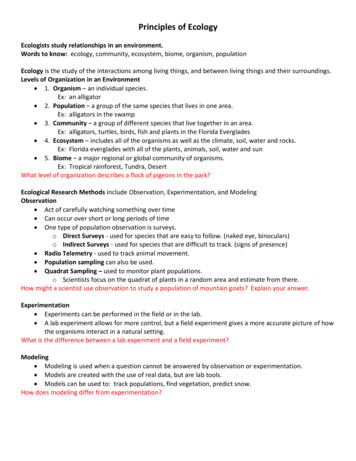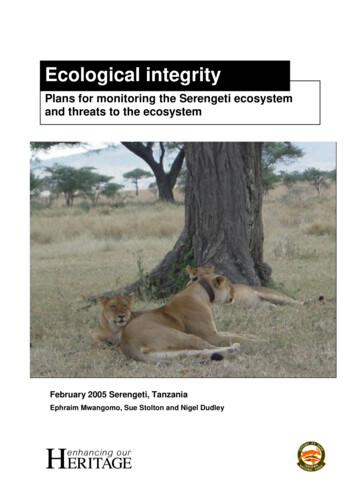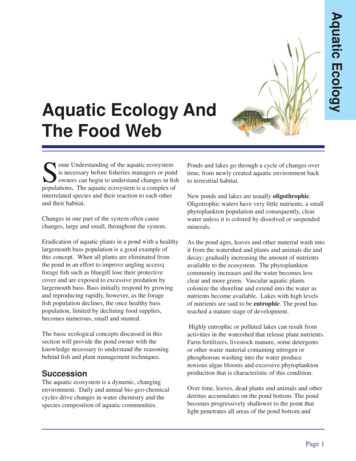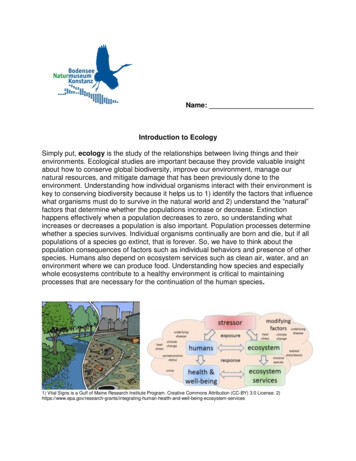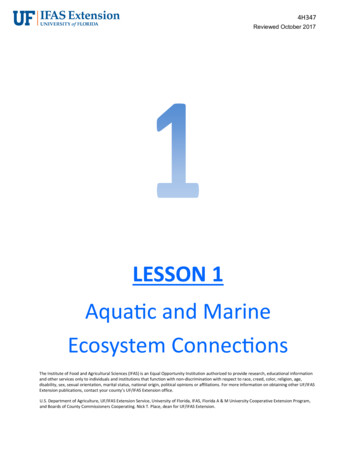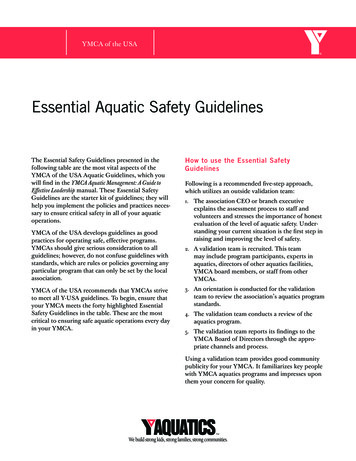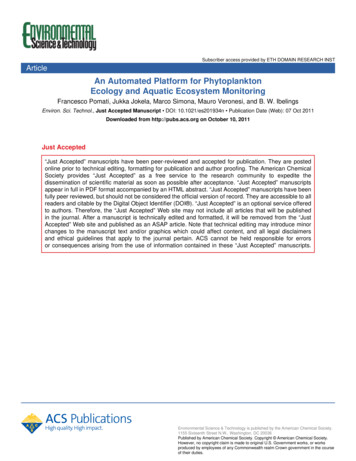
Transcription
Subscriber access provided by ETH DOMAIN RESEARCH INSTArticleAn Automated Platform for PhytoplanktonEcology and Aquatic Ecosystem MonitoringFrancesco Pomati, Jukka Jokela, Marco Simona, Mauro Veronesi, and B. W. IbelingsEnviron. Sci. Technol., Just Accepted Manuscript DOI: 10.1021/es201934n Publication Date (Web): 07 Oct 2011Downloaded from http://pubs.acs.org on October 10, 2011Just Accepted“Just Accepted” manuscripts have been peer-reviewed and accepted for publication. They are postedonline prior to technical editing, formatting for publication and author proofing. The American ChemicalSociety provides “Just Accepted” as a free service to the research community to expedite thedissemination of scientific material as soon as possible after acceptance. “Just Accepted” manuscriptsappear in full in PDF format accompanied by an HTML abstract. “Just Accepted” manuscripts have beenfully peer reviewed, but should not be considered the official version of record. They are accessible to allreaders and citable by the Digital Object Identifier (DOI ). “Just Accepted” is an optional service offeredto authors. Therefore, the “Just Accepted” Web site may not include all articles that will be publishedin the journal. After a manuscript is technically edited and formatted, it will be removed from the “JustAccepted” Web site and published as an ASAP article. Note that technical editing may introduce minorchanges to the manuscript text and/or graphics which could affect content, and all legal disclaimersand ethical guidelines that apply to the journal pertain. ACS cannot be held responsible for errorsor consequences arising from the use of information contained in these “Just Accepted” manuscripts.Environmental Science & Technology is published by the American Chemical Society.1155 Sixteenth Street N.W., Washington, DC 20036Published by American Chemical Society. Copyright American Chemical Society.However, no copyright claim is made to original U.S. Government works, or worksproduced by employees of any Commonwealth realm Crown government in the courseof their duties.
Page 1 of 4555657585960Environmental Science & Technology1An Automated Platform for Phytoplankton2Ecology and Aquatic Ecosystem Monitoring3FRANCESCO POMATI1*, JUKKA JOKELA1,2, MARCO SIMONA3, MAURO4VERONESI3, BAS W. IBELINGS1,451Swiss Federal Institute of Aquatic Science and Technology (EAWAG), Department of678Aquatic Ecology, Seestrasse 79, 6047 Kastanienbaum, Switzerland2ETH-Zürich, Institute of Integrative Biology (IBZ), Department of EnvironmentalSciences, Aquatic Ecology, Überlandstrasse 133, 8600 Dübendorf, Switzerland39104Istituto Scienze della Terra, IST-SUPSI, 6952 Canobbio, SwitzerlandNetherlands Institute of Ecology (NIOO-KNAW), Droevendaalsesteeg 10,116708 PB Wageningen, The Netherlands1213* Corresponding author:14Phone 41 58 765 2174; Fax 41 58 765 2162; email: francesco.pomati@eawag.ch15161ACS Paragon Plus Environment
Environmental Science & 0515253545556575859601Abstract2High quality monitoring data are vital for tracking and understanding the causes of3ecosystem change. We present a potentially powerful approach for phytoplankton and4aquatic ecosystem monitoring, based on integration of scanning flow-cytometry for the5characterization and counting of algal cells with multi-parametric vertical water profiling.6This approach affords high-frequency data on phytoplankton abundance, functional traits7and diversity, coupled with the characterization of environmental conditions for growth8over the vertical structure of a deep water body. Data from a pilot study revealed effects9of an environmental disturbance event on the phytoplankton community in Lake Lugano10(Switzerland), characterized by a reduction in cytometry-based functional diversity and11by a period of cyanobacterial dominance. These changes were missed by traditional12limnological methods, employed in parallel to high-frequency monitoring. Modeling of13phytoplankton functional diversity revealed the importance of integrated spatio-temporal14data, including circadian time-lags and variability over the water column, to understand15the drivers of diversity and dynamic processes. The approach described represents16progress towards an automated and trait-based analysis of phytoplankton natural17communities. Streamlining of high-frequency measurements may represent a resource for18understanding, modeling and managing aquatic ecosystems under impact of19environmental change, yielding insight into processes governing phytoplankton20community resistance and resilience.212ACS Paragon Plus EnvironmentPage 2 of 31
Page 3 of 45556575859601Environmental Science & TechnologyIntroduction23Freshwater ecosystems are characterized by high levels of biodiversity, and are enniumassessment:5http://www.maweb.org). Understanding and managing environmental change in aquatic6ecosystems is complicated by co-occurring and interacting stressors like climate change,7eutrophication and pollution that, for example, can interact to favor harmful algal blooms8[3-6]. We suffer from a general lack of knowledge on the background rates and direction9of change in pristine ecological systems, as well as in stressed ecological communities10[7]. These limits can hamper our ability to detect the signature of a range of11anthropogenic impacts on ecosystems, or predict patterns of recovery.12Phytoplankton communities are highly diverse and dynamic. They respond rapidly to13climate change, eutrophication and pollution, and play an important role in aquatic14ecosystem biogeochemical processes [4, 8-14]. Phytoplankton density (algal blooms) and15community composition (e.g. toxic cyanobacteria) are the prime agents impacting water16quality, ecosystem and human health [15], and have been suggested to be used as such for17ecosystem assessment [16-19]. Monitoring, understanding and predicting changes in18structural (composition, diversity, evenness) and functional (phenotypic characteristics,19growth rate, productivity) aspects of phytoplankton communities across space and over20time represents however a challenge for aquatic ecology. The capturing of population21dynamics, community succession and adaptation to environmental change requires: 1)22high-frequency sampling to follow fast plankton fluctuations [20] and potential chaotic23dynamics [21]; 2) vertical (depth) distribution of algal taxa and their physio-3ACS Paragon Plus Environment
Environmental Science & 0515253545556575859601morphological characteristics (traits) [22]; 3) a functional, trait-based assessment of2communities and ecosystems based on the characteristics of the organisms’ phenotypes3that directly respond to environmental changes and determine effects on aggregated4processes [13, 23, 24].5The goal of this article is to present an integrated platform able to: 1) provide6automated high-frequency measurements of phytoplankton at different lake depths; 2)7couple in situ biological monitoring with data about the physical environment; 3) provide8a streamline of real-time data for modeling and forecasting phytoplankton dynamics. By9integrating a CytobuoyTM with an IdronautTM vertical profiling system, we addressed the10objective of increasing spatio-temporal resolution in field data collection. It has been11proposed that scanning flow-cytometry, offered by instruments like the commercially12available CytobuoyTM, may offer advantages over microscopic methods for cell counting13and classification of phytoplankton, including the possibility of automation and high14frequency field measurements of phytoplankton physio-morphological characteristics15[20, 25-27]. A novel aspect of our monitoring approach therefore lays in the use of16cytometry-data for a description of phytoplankton functional diversity and expressed17phenotypic traits, which allow tracking phytoplankton responses at the functional group18level. Trait-based approaches and functional groups are becoming increasingly important19in understanding phytoplankton ecology [22, 28-30].20In this study we tested our monitoring platform optimized for deep water bodies,21designed to afford comprehensive data to study phytoplankton ecology and to improve22water resource management. To support the validity of our approach we report the results23form a monitoring campaign (spanning roughly one month in May 2010) during which4ACS Paragon Plus EnvironmentPage 4 of 31
Page 5 of 4555657585960Environmental Science & Technology1automated measurements were coupled by fortnightly limnological data (physics,2chemistry and biology) [31].34Materials and methods56Automated monitoring platform. Phytoplankton counting, characterization and7classification were performed using a scanning flow cytometer CytobuoyTM (Woerden,8the Netherlands), designed to analyze the full naturally occurring range from small (e.g.9picoplankton) to large (e.g. colonial cyanobacteria) planktonic particles (1 to 700 µm in10diameterandafewmminlength)andrelatively largewatervolumes11(http://www.cytobuoy.com) [25] (Fig. S1-e). In our instrument, particles were intercepted12by two laser beams (Coherent solid-state Sapphire, 488 nm and 635 nm, respectively, 1513mW) at the speed of 2 m s-1. In this study, digital data acquisition was triggered by the14sideward scatter (SWS) signal (908 nm). The light scattered at two angles, forward15(FWS) and SWS, provided information on size and shape of the particles. The16fluorescence (FL) emitted by photosynthetic pigments was detected as red (FLR), orange17(FLO) and yellow (FLY) signals collected in the wavelength ranges of 668-73418(chlorophyll-a, Chl-a), 601-668 (phycocyanin and phycoerythrin) and 536-601 nm19(degraded pigments), respectively. Laser alignment and calibration processes were done20before the monitoring campaign using yellow FL beads of 1 and 4 µm diameter.21Our CytobuoyTM allowed automatic acquisition of particles in time-intervals, time-22specific measurement, and fixed-measurement on occurrence of a trigger signal (see23below). This study was based on automated acquisition of 2 fixed-measurements for5ACS Paragon Plus Environment
Environmental Science & 0515253545556575859601every trigger-signal received in order to optimize the detection and quantification of2small and large particles in two separated analyzes, and on a scheduled time-specific3background measurement per day with water being sampled at 25 m (no phytoplankton4growth). Remote accessibility of the CytobuoyTM via the internet-UMTS network allowed5unlimited data access and transmission rates along with increased location flexibility.6Further technical details on our CytobuoyTM, measuring settings and configurations are7reported in the Supplemental Online Material.8In order to accomplish depth resolution, we employed a vertical profiling system made9up of three integral parts: Controller Module (Fig. S1-a,-b), Profiler Module (Fig. S1-b),10and OCEAN SEVEN 316Plus CTD (O7) multiparameter probe (Fig. S1-c) (Idronaut,11Brugherio, Italy, www.idronaut.it). The O7-probe was equipped with seven sensors:12pressure, temperature ( C), conductivity (µS, absolute and at 20 C), pH, oxygen (mg / L13and % saturation), and NO3 (µg /L) (IdronautTM). An external TriLux fluorimeter was14interfaced with the O7 probe in order to quantify levels of Chl-a, phycoerythrin and15phycocyanin (Chelsea Technologies Ltd, Surry, UK). More information on the16IdronautTM profiling system can be found in the Supplemental Online Material.17For automatic depth profiles, we allowed the CytobuoyTM to accept an electric signal18from the IdronautTM Controller Module as a trigger to start the measurement cycle during19O7 step-profiles. We ran two independent automatic monitoring programs, one with the20CytobuoyTM and one only with the O7-multiparameter probe, with separated profile21settings and different monitoring frequencies. In this study we scheduled a step profile22involving six depths - covering the entire photic zone - with the CytobuoyTM (2, 4, 6, 8,2310 and 12 m) and a continuous profile with the O7-multiparameter probe from 1 to 20 m6ACS Paragon Plus EnvironmentPage 6 of 31
Page 7 of 4555657585960Environmental Science & Technology1to be performed twice a day each, to catch diel variations in the temperature structure of2the water column: the theoretical maximum and minimum daily stratification at 3 pm and33 am (12 h frequency), respectively.4For step-profile phytoplankton measurements, we retrieved water from selected depths5using an external pump (capacity 1 L min-1), an antimicrobial silver-nanoparticle coated6and shaded flexible polyethylene tubing (FlexeleneTM, Eldon James Corp., Loveland,7Colorado, USA), and a surface plexiglass chamber (250 mL) from which the CytobuoyTM8sub-samples through a needle injector (Fig. S1-e). The pump was placed downstream9from the chamber in order to avoid damaging algal cells or colonies prior to10measurements. More information on structural components of the monitoring platform,11how we integrated our instruments to achieve depth profiles, and an example of12automated operation using the integrated system and maintenance details are reported in13the Supplemental Online Material.14Sampling. The automated monitoring platform was moored in Lake Lugano, at a site15protected from strong winds and currents and close to the location of the routine historic16lake monitoring program (coordinates 45 57'33.43"N, 8 52'53.49"E) (Fig. S2). This site17is representative for the most eutrophic of the lake’s three distinct basins [31] (Fig. S2).18Data presented in this article refer to the monitoring period from the 28th of April to the1931st of May 2010 (with 6 depths over the photic zone and a frequency of two profiles per20day). Independent limnological data were collected at 300 m distance from the platform21with a fortnightly frequency. They included physical characteristics of the whole water22column, chemical analyses on algal nutrients and integrated phytoplankton samples (from230 to 20 m). Additional information on these data can be found in the Supplemental Online7ACS Paragon Plus Environment
Environmental Science & 0515253545556575859601Material. For comparison between cytometry-based richness and phytoplankton species2richness (Table 1, Fig. S6) we used additional samples from Lake Lugano collected3between June and December 2010 and data from a study conducted in Lake Zurich4during spring 2009 [32] (Supplemental Online Material).5Data analysis. Data manipulation, analysis and graphics were performed in the R6programming language (www.r-project.org). The CytobuoyTM provided 54 descriptors of73D structure and FL profile for each particle [25]. Datasets also included original8sampled volume, date, time and depth at which particles were taken. We visually9inspected the distribution of raw data with regards to FL signals and set database-specific10threshold levels to divide fluorescent (FL) from non-FL particles. The overall FL and11non-FL databases comprised 1 and 5 million particles, respectively.12CytobuoyTM particle descriptors were standardized to zero mean and unit variance and,13by principal component analysis, reduced to 33 orthogonal vectors covering 99 % of total14variance in the data (data not shown). Principal components were utilized for grouping15particles into functional categories using K-means clustering. We compared several K16values and selected the optimal number of K based on the within groups sum of squares17[33]. Phytoplankton densities were calculated by inferring the number of cells from the18number of humps in the SWS signal of each particle to account for colonial species [20,1925]. O7 sensor data were organized in a separated database. Cyanobacterial-like particles20were identified based on FLO and FLR emissions after excitation by the 495 nm and 63521nm lasers, respectively, after visual inspection. These signals are expected as a response22to the presence of the cyanobacterial-specific pigment phycocyanin [25].8ACS Paragon Plus EnvironmentPage 8 of 31
Page 9 of 4555657585960Environmental Science & Technology1We modeled richness of CytobuoyTM-derived functional groups of phytoplankton2(response variables) in the upper 12 m of the water column based on high frequency3environmental data (explanatory variables). Explanatory variables included: water4parameters (mean of top 12 m), coefficient of variation (CV SD / mean) of parameters5over water-column and meteorological data at time-lag(0), -lag(1) ( 24h) and -lag(2)6( 48h). The response variables showed significant temporal autocorrelation only at time-7lag(1) (data not shown). We therefore included for each model the response variable at8time-lag(1) as explanatory, in order to account for temporal autocorrelation of data. All9variables were scaled in order to standardize effect sizes and let to compete in the same10model. The best model was selected based on Akaike's information criterion (AIC) with a11stepwise procedure (alternation of forward selection and backward elimination of12variables with p 0.05) [34]. The relative importance of drivers was assessed by13bootstrapping (999 times) the percentage contribution to the R2 of the model among the14regressors, and extracting the relative 95% confidence intervals.1516Results and Discussion1718Phytoplankton depth heterogeneity. Our monitoring approach was able to reveal fine19changes in the relative depth distribution of phytoplankton functional-group richness,20Chl-a concentration and cell density with statistically significant differences between day21and night profiles (Supplemental Results, Fig. S3-S4). Similar data have been observed22using flow-cytometry in oceanic profiles of phytoplankton communities [35-37]. We did23not observe a significant difference in the vertical physical structure of the water column9ACS Paragon Plus Environment
Environmental Science & 0515253545556575859601between day and night profiles (Fig. S3-S4), and limited changes between day and night2air-temperatures during the study period (data not shown). Our data suggest that depth-3specific day-night dynamics in phytoplankton community composition and abundance are4driven by biological factors, rather than environmental changes (Supplementary Results5and Discussion).6Temporal phytoplankton dynamics. The frequency and intensity of phytoplankton7blooms are key elements for ecological status definition [16, 17, 19]. Considering that8most algal taxa can reach bloom conditions and disappear within a few days (implying a9maximum oscillation frequency of 2-3 density peaks per week), a minimum sampling10frequency of 4 to 6 times per week would be needed to follow algal dynamics (Nyquist11frequency, Table 1) and quantify their intensity adequately [20].12Our automated monitoring platform was able to perform 2 vertical profiles per day (at a13fixed depth the maximum frequency could be of 6 samples per hr). Figure 1 reports14results from daily monitoring samples (time is 3 pm, frequency 1 day-1) during the15study. This frequency was capable of capturing fine fluctuations in FL particle density16(phytoplankton) and total Chl-a concentration over the water column (Fig. 1A). Our data17were comparable to previous work using flow-cytometry in the field in terms of temporal18resolution on algal dynamics ([27] and literature therein). Measured phytoplankton19density was comparable with microscopic counts and correlated well with Chl-a20concentration levels (Fig. 1A) (R2-adjusted 0.651, p 4.324-08), as also reported21elsewhere [32]. Our system was able to follow dynamics of non-FL particles (suspended22solids, dead cells, heterotrophic bacteria), which did not correlate with algal cell10ACS Paragon Plus EnvironmentPage 10 of 31
Page 11 of 4555657585960Environmental Science & Technology1concentrations apart from a short period in the middle of the time-series (days 15 to 18)2(Fig. 1A).3Previous work using flow cytometry in phytoplankton aimed at identifying broad4functional groups (such as picoeukaryotes, microalgae, cyanobacteria, etc.) and some5phytoplankton species with clearly distinguished morphology or pigmentation (such as6Pseudo-nitzschia, Cryptomonas, Synura, Dinobryon) [20, 25, 27, 38] (and literature7therein). This type of analysis lacked a proper measure of diversity. We used the8CytobuoyTM to describe key phytoplankton traits like size, coloniality, pigment type and9content, which we used to create groups of functionally similar individuals [29, 30]. The10possibility of monitoring individually measured phytoplankton physio-morphological11descriptors may offer the best prospects in terms of objectivity, reproducibility, functional12properties and prediction of algal assemblages [22, 23, 30]. The number of CytobuoyTM-13derived functional groups was comparable with the total number of species detected in14the photic zone of the water column (Fig. 1B, Fig. S6), as also reported elsewhere [32].15Generally, the number of functional groups in a community is smaller than the number of16species, since in current functional classification methods more than one species can be17assigned to the same functional category [29, 30]. With our trait-based approach,18however, it is also possible that individuals of the same species can be allocated to19different functional groups based on their expressed morphology (for example, colonial20species can be assigned to two different groups depending on whether they are present as21single cells or colonies). The CytobuoyTM description of the relative abundance of22phytoplankton functional groups deviated from microscopically measured evenness (Fig.231B). This could be caused by superior precision of automated density measurements, and11ACS Paragon Plus Environment
Environmental Science & 0515253545556575859601to the fact that the identity (and abundance) of CytobuoyTM-derived functional groups2does not fully reflect the identity (and abundance) of microscopically defined taxonomic3groups as reported above (several species can map into one functional category and4individuals of the same species can be assigned to different groups).5We observed a strong decrease in phytoplankton functional richness and evenness in6the middle of the time-series (Fig. 1B), followed by a short recovery period that led to7higher cell density (Fig. 1A). These dynamics were completely missed by the fortnightly8limnological sampling (Fig. 1). Our approach offered the advantage of having automated9measurements of environmental conditions for the observed algal dynamics (Fig. S7). Six10days of rainy and stormy weather (Table S1) were associated with a period of low11phytoplankton diversity and productivity (with high levels of non-FL particles), and a12decrease in CV in temperature and conductivity over the first 12 m of the water column.13This eventually led to a mixing event on day 19 (Fig 1C, Fig. S7). The phytoplankton14community in the days preceding disturbance (started at day 5) showed a gradual decline,15reaching the minimum of evenness and richness just before the mixing event (on days 1716and 18, respectively). The mixing event re-established evenness in the community that17fully recovered functional diversity in 6 days (Fig. 1B-C). Functional diversity, as18opposed to taxonomic diversity, appears to be a better predictor of ecosystem functioning19across a range of communities and measures of functional diversity may afford a better20description of the functionality of the ecosystem and its resilience to disturbance [12, 13,2123, 24, 39].22Using CytobuoyTM-derived phytoplankton traits. Our approach allows tracking23phytoplankton physio-morphological characteristics such as cell size and shape (which12ACS Paragon Plus EnvironmentPage 12 of 31
Page 13 of 4555657585960Environmental Science & Technology1influence motility and nutrient uptake through surface/volume ratio), photosynthetic2performance (driven by pigment type and concentration), active nutrient uptake and3coloniality [22]. Cell size and photosynthetic performance are key phytoplankton traits,4affecting growth, metabolism, access to resources, susceptibility to grazing, and are5extremely plastic responding to the environment and to species interactions [22, 32].6Analysis of dynamics and distributions of these focal phytoplankton traits could improve7our forecasting capabilities of community structure and ecosystem functions [12, 13, 24,839]. Pigment profiles can also be used to specifically target certain phytoplankton groups9of interest in their spatio-temporal dynamics [20, 25].10We report temporal changes in mean and variance of phytoplankton size and suspended11non-FL particles size (Fig. 2A, Fig. S8). In addition, we tracked the dynamics in12abundance of cyanobacteria using CytobuoyTM data and phycocyanin / Chl-a13concentration ratios obtained with the O7-probe (Fig. 2B). Shortly before “disturbance”14(days 15-17), a period characterized by low diversity and productivity (Fig. 1), the study15site was dominated by large cyanobacterial colonies (Fig. 2A-B). Mean water column16cyanobacterial density obtained by the CytobuoyTM was almost identical to microscopic17count levels (Fig. 2B) and was likely associated with the presence of Planktothrix18rubescens filaments (Table S2). The mixing event rapidly and dramatically reduced19cyanobacterial abundance and the average size of the phytoplankton community (Fig. 2)20[40]. Variation in the dimensions of non-FL particles appeared to be very small compared21to the dynamics in phytoplankton size (note the y-axis scales in Fig. 2A). Compared to22conditions before the disturbance, the final days of our time-series were characterized by23smaller size phytoplankton cells (Fig. 2A), probably eukaryotic nanoplankton of genera13ACS Paragon Plus Environment
Environmental Science & 0515253545556575859601Stephanodiscus and Melosira (Table S2), dominating a more productive (Fig. 1A) and2diverse community (Fig. 1B, Fig. S8).3Our approach introduces the possibility of monitoring a large number of phytoplankton4individuals and their traits per population or through the entire community. Individuals5and populations should be the basic units of investigation to assess the status of6communities and ecosystems, since they respond phenotypically (and genetically) to7disturbance or stress and eventually evolve altering community processes and ecosystem8functioning [41].9Modeling high-frequency phytoplankton dynamics. Our automated monitoring10approach allows to better couple environmental forcing with phytoplankton community11dynamics, in particular at the functional level (which may relate to crucial ecosystem12services [13, 24, 42]). Using data from the period of study, we modeled the CytobuoyTM-13based phytoplankton functional richness in order to provide an example of how spatio-14temporal measurements of environmental conditions, coupled with biological data, can15provide insight into drivers of community responses and changes.16Temperature (both atmospheric and water), conductivity (whose main contributors17were carbonate and bicarbonate ions) and the heterogeneity of environmental conditions18over the water column appeared to be the most important drivers of phytoplankton19functional richness (Table 2). Most of the drivers appeared to influence the response20variable with a time lag of 24 or 48 h (Table 2). Our modeling exercise highlights the21importance of i) time-lags between environmental change and response at the level of22phytoplankton community, ii) variability of parameters over the water column (depth23heterogeneity), and iii) in situ meteorological conditions for understanding and modeling14ACS Paragon Plus EnvironmentPage 14 of 31
Page 15 of 4555657585960Environmental Science & Technology1phytoplankton community dynamics. Intensity of fluctuations and heterogeneity by depth2in key environmental variables may represent fundamental factors to understand and3predict changes in plankton diversity [14]. The collection of the above type of high-4resolution data would be intractable without the aid of an in situ automated monitoring5station like the one presented in this study. A similar approach can be used to model and6forecast cyanobacterial blooms.7Towards an adaptive, integrated approach to aquatic ecosystem monitoring.8Monitoring frameworks that evolve along w
1 1 An Automated Platform for Phytoplankton 2 Ecology and Aquatic Ecosystem Monitoring 3 FRANCESCO POMATI 1*, JUKKA JOKELA 1,2, MARCO SIMONA 3, MAURO 4 VERONESI 3, BAS W. IBELINGS 1,4 5 1 Swiss Federal Institute of Aquatic Science and Technology (EAWAG), Department of 6 Aquatic Ecology, Seestrasse 79, 6047 Kastanienbaum, Switzerland 7 2 ETH-Zürich, Institute of Integrative Biology (IBZ .


